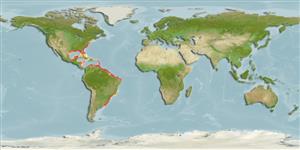Common names from other countries
Environment: milieu / climate zone / depth range / distribution range
بوم شناسي
دريايي; لب شور موجوداتی که در محدوده وسیعی از آبهای آزاد از نزدیک بستر و یا روی کف بستر، در قسمت های میان آبی تا سطح آب و در برخی گونه ها با قابلیت پرواز، زندگی و تغذیه می کنند.; تغييرات عمق 15 - 136 m (Ref. 36453). Subtropical; - 38°S
Western Atlantic: northeastern USA to Rio de Janeiro, Brazil, sometimes reaching Argentina.
Length at first maturity / Size / Weight / سن
Maturity: Lm 12.0 range ? - ? cm
Max length : 36.0 cm TL جنس نر / بدون خواص جنسي; (Ref. 39376); common length : 18.0 cm TL جنس نر / بدون خواص جنسي; (Ref. 5217)
خارهاي باله پشتي (کل) : 2 - 5; شعاع نرم باله پشتي (کل) : 38 - 47; خارهاي باله مخرجي: 2 - 3; شعاع نرم باله مخرجي: 35 - 45. This species is distinguished by the following characters: body very deep (its depth 1.6 to 1.8 in total length), bounded by even curves and strongly compressed; snout short and blunt, about equal to eye diameter; mouth small, tip of maxillary just reaching to below eye margin; teeth in jaws weak, in 1 row, those in the upper jaw slightly recurved, simple and pointed; dorsal and anal fin bases very long (about equal in length), both fins falcate, the length of their longest rays greater than head and preceded by 3 weak spines; caudal fin stiff and deeply forked, both its lobes longer than head; pectoral fins narrow and much longer than head; pelvic fins absent; no conspicuous series of pores below dorsal fin; lateral line high, following dorsal profile; scales small and easily detached, extending to cheeks and bases of vertical fins; body color pale blue to green above, silvery with a golden/yellow tinge below (Ref. 53006).
A pelagic fish forming large schools in coastal bays, inshore waters over the continental shelf and around islands at moderate depths (50 to 70 m) where it occurs throughout the year (Ref. 53006). Juveniles are found in shallow coastal waters under floating weeds; also in or near brackish estuaries (Ref. 5217). The young of less then 10 cm length are often encountered in association with medusae. Adults feed mainly on jellyfish, small fish, crustaceans and worms while juveniles are plankton feeders. Caught mainly with otter trawls, also seines; marketed fresh and frozen (Ref. 53006). Its flesh is well esteemed.
Life cycle and mating behavior
Maturities | تولید مثل | Spawnings | Egg(s) | Fecundities | توزاد ( لارو)
Cervigón, F., 1994. Los peces marinos de Venezuela. Volume 3. Fundación Científica Los Roques, Caracas,Venezuela. 295 p. (Ref. 13628)
وضعيت در فهرست قرمز IUCN (Ref. 130435)
CITES (Ref. 128078)
Not Evaluated
خطر برای انسان ها
Harmless
استفاده انسانی
ماهي گيري – شيلات: ارزش تحاري اندك
ابزارها
گزارش های ويژه
بارگيری XML
منابع اينترنتي
Estimates based on models
Preferred temperature (Ref.
115969): 14.8 - 27.4, mean 24.2 (based on 268 cells).
Phylogenetic diversity index (Ref.
82804): PD
50 = 0.5020 [Uniqueness, from 0.5 = low to 2.0 = high].
Bayesian length-weight: a=0.01622 (0.01290 - 0.02039), b=2.95 (2.89 - 3.01), in cm Total Length, based on LWR estimates for this species (Ref.
93245).
Trophic level (Ref.
69278): 4.5 ±0.0 se; based on diet studies.
جهندگی (Ref.
120179): زياد, كمينه زمان لازم براي دو برابر شدن جمعيت ، كمتر از 15 ماه (Preliminary K or Fecundity.).
Fishing Vulnerability (Ref.
59153): Low to moderate vulnerability (26 of 100).
